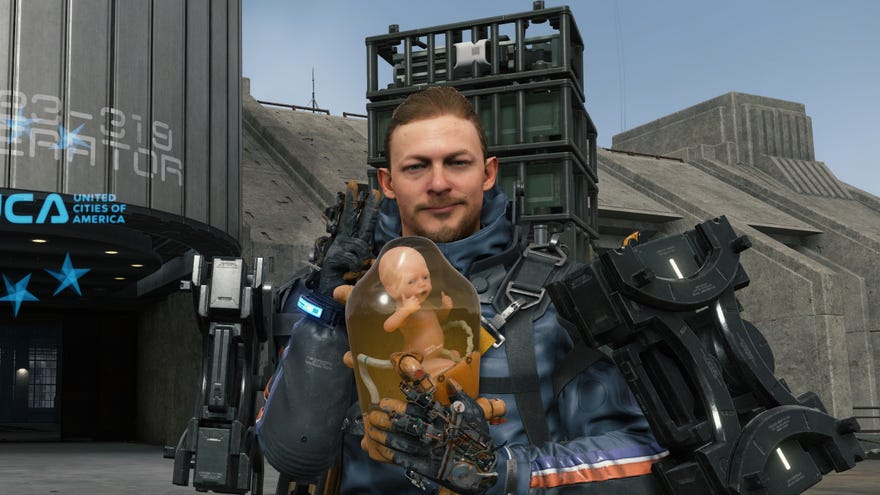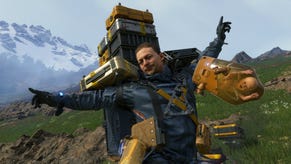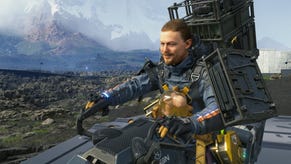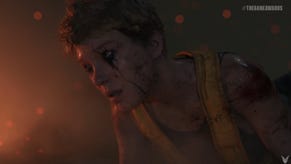The Death Stranding books made me realise how much gameplay can impact story
Bless this mess
As you may have seen earlier this week, I spent much of my downtime this month reading the official novelisation of Hideo Kojima's courier hiking sim Death Stranding. It was quite a strange experience, if only because so much of what I loved about the game wasn't present in the novels at all. The landscape you spend so much time analysing and assessing in Death Stranding is barely mentioned over the course of the books, and even the deadly BTs get surprisingly little air time for how often they seem to get in your way. But the strangest thing of all was how it depicted Sam's relationship with his jar baby BB, and it made me realise that all the weird, extraneous mess in its overall design is actually pretty darn important when it comes to establishing some of its later story reveals. I love a good game story as much as the next person, but when it's not supported by gameplay, something definitely comes a cropper.
Let me explain. In the game and the book, Sam's BB, or Bridge Baby, is often described as "a piece of equipment". They're tools porters use to detect the presence of dangerous BT ghosts that could potentially cause a massive nuclear explosion, or 'voidout' in the game's parlance, if they come into contact with the living. It's a weird concept, to be sure, but it's one that sits at the heart of the game's story, and its overall design. The clincher, of course, is that to all intents and purposes BB looks and often acts just like a regular human baby, and the game takes great pains in its various cutscenes to ask the obvious questions like, "How can a baby just be a piece of equipment to the Bridges company?" and "Have we really sunk so low that we don't regard children as being human anymore?" The book does this, too, if only because it often lifts those cutscene conversations word for word straight out of the game.
Over the course of playing Death Stranding, however, the way the game's been designed constantly seems to buck the idea of what's been repeatedly hammered home to you by its various characters. Far from being just another tool like a climbing hook or Sam's plentiful supply of ladders you use to navigate the world in front of you, this BB is special.

You hear it in the way BB laughs and giggles when you stumble over a rock or do a cool wheelie in your truck as you take a corner too fast, as well as when they cry and wail in response to you wading too deeply into a body of water or frantically legging it from a BT encounter because you've run out of blood grenades.
You see it when BB blows little heart bubbles at you in their tank when you pause to rock them for a bit, and the way they paddle around in their jar like a little motor boat when you stop to take a bath in one of the game's occasional hot springs. Heck, even manipulating BB's pose and facial expression in the game's rather brilliant and extensive photo mode helps, in some small way, to reinforce this strange and definitely not parental relationship you're establishing with this weird little jar baby.
Many of these things don't really serve the game's underlying systems. As Kitfox Games' Tanya X Short mentioned in her article 'In Praise of Messy Game Design' the other week, it is not thematically important that Sam is able to relieve his bladder at any point you're outside. But goodness if BB's gleeful gurgling doesn't make me feel like he's revelling in the sheer preposterousness of it as well.
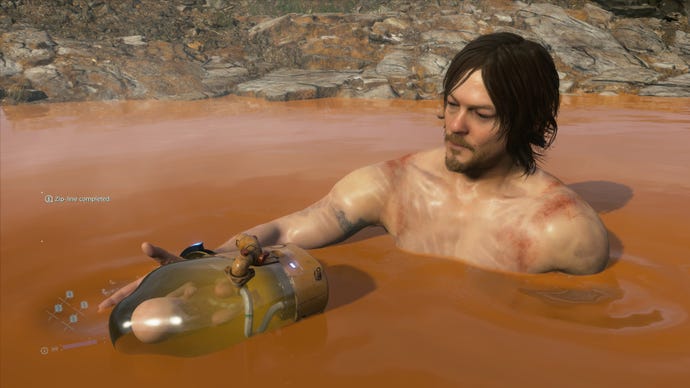
It's these little moments and BB's increasingly human reactions to the things you do in Death Stranding that really helped to forge the bond I felt between Sam and BB, which in turn gives you more and more evidence that the game's claims about BB just being a piece of equipment have to be false. This makes it all the more painful when Sam has leave BB for a bit about halfway through the game so Deadman (aka Guillermo del Toro's character) can 'reset' BB to prevent them from malfunctioning further. It also makes you doubt your assumptions when Sam and BB are eventually reunited and BB seems to have 'forgotten' everything you've just been through. Maybe they are just a piece of equipment after all.
And yet (spoiler alert) during the game's finale, it's final, final, final climax when you're tasked with retracing the steps you made right at the start of the game up to Capital Knot City's ominous incinerator, this time to dispose of your now seemingly permanently shut down BB (my heart!), you still hope against all hope that maybe, just maybe, there's a spark of life left in them after all. That they're not just a broken tool that needs throwing away. That they're alive and human and conscious just like Sam is - and it's all because you're given the space and the latitude to interact with BB during the course of your journey together.
The books have none of this. The novelised version of BB is a much more passive creation, and most of the time BB is either described as simply being asleep or not visible at all due to the jar going dark. Sam occasionally rubs BB's jar in an attempt to quell his own feelings of unease, but there's very little interaction from BB themselves. I mean, you don't even get the benefit of seeing BB react to things like BT encounters or the way Sam moves through the landscape, as these are all sidelined in the books in favour of exploring other characters' backstories. You actually get very little time with the BB Boys compared to how long you spend with them in the game, and as readers it means we have fewer opportunities to start challenging what everyone in the books keep telling us about BB's true nature.

With so little to hang their relationship on in the books, I found those latter story moments with BB rang rather hollow. Spoiler alert, but it just doesn't make sense for Sam to suddenly start projecting the loss of his own child onto BB once they're reunited after their brief separation, because to all intents and purposes these feelings of deep, parental attachment have pretty much come out of nowhere. Instead, all you've really got to go on regarding the whole, "Could this BB actually be more than just a tool?" question are the expanded thoughts of Deadman himself as he continues his research into the origins of the BB program and whether there might be a way to save the one given to Sam (although even this feels somewhat contrived in the books, as Deadman simply 'decides' to help Sam save BB-28, with little to no explanation as to why).
It's just nowhere near as satisfying, and it made me realise just how important all of those seemingly inconsequential gameplay moments are in Death Stranding, and what they were actually trying to achieve. When looked at individually, they're probably very much the epitome of Short's 'messy' design theory - the extra, unnecessary indulgences that defy sense and logic in favour of a director's 'vision'. And yes, maybe if the books had spent a bit more time with Sam and BB then we might not be having this discussion in the first place. But when you're presented with a version of this story that isn't 'messy', so to speak, and has those extraneous elements excised from its narrative, only then can we start to see their true value, and how it's in the doing rather than the telling that's so important.
